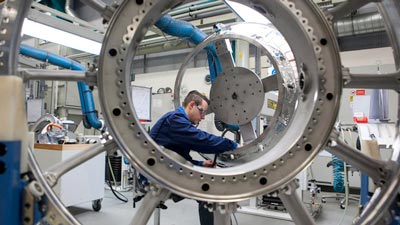E.U’s economy is growing due to Germany and Italy manufacturing

Euro-area manufacturing grew at the fastest pace in three months in April on accelerating expansion in Germany and Italy, evidence the currency bloc’s recovery remains on track.
A Purchasing Managers’ Index increased to 53.4 from 53 in March, Markit Economics said in a statement today. That exceeded a preliminary reading of 53.3 published on April 23. The measure has exceeded the level of 50, indicating expansion, for the past 10 months.
While the euro area is recovering from a record-long recession and confidence indicators signal further growth, officials are gauging the risk that low inflation might evolve into falling prices. The threat has prompted European Central Bank President Mario Draghi to pledge further monetary stimulus if needed.
“The recovery is becoming more broad-based,” said Chris Williamson, an economist at Markit. “It remains to be seen whether this strengthening of demand will feed through to more pricing power, which remains weak due to the widespread existence of spare capacity and high unemployment in many countries.”
Markit’s report showed input costs in the euro region fell at the fastest pace since July 2013, while output prices declined for a second month.
Inflation Outlook
Euro-area inflation was 0.7 percent in April, compared with 0.5 percent in March, well below the ECB’s target of just under 2 percent. At the same time, the core rate, which strips out volatile items such as energy or food, rose to 1 percent.
The ECB in March forecast inflation to gradually accelerate to 1.5 percent in 2016. The Frankfurt-based central bank will release new projections in June.
A gauge of German factory output increased to 54.1 from 53.7 in March, while Italy’s index rose to 54, the highest since April 2011. Spain’s gauge was little changed at 52.7 compared 52.8 in March and France’s measure slid to 51.2 from 52.1.
“While Germany, Spain and Italy are enjoying a good start to 2014 so far, France remains a concern,” Williamson said. “The key to the divergence appears to lie largely in export performance and competitiveness.”
Euro-area unemployment remained at 11.9 percent in March, close to a record high, according to a separate Bloomberg News survey of economists. The European Statistics office is due to publish the jobless number at 11 a.m. in Luxembourg today.
The state of the economy is “pretty severe,” Draghi said last month. His “biggest fear” is a protracted stagnation that leads to high unemployment rates becoming structural, he said on April 3 after officials kept the benchmark interest rate unchanged at a record-low 0.25 percent.
The ECB’s 24-member Governing Council will gather in Brussels next week and announce its interest-rate decision on May 8.
Source: bloomberg





























